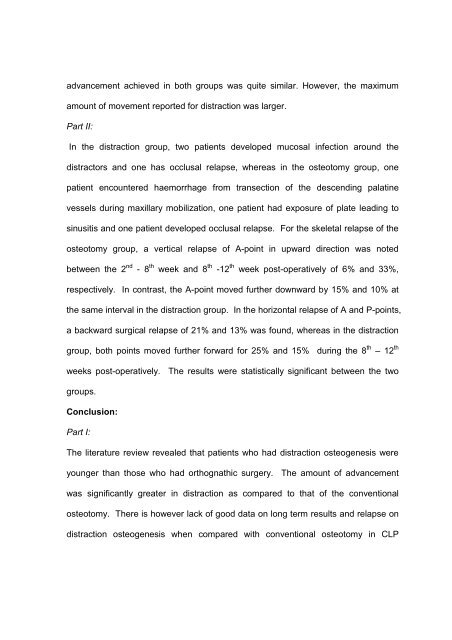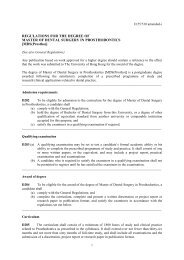Abstract Objectives: 1. To compare the surgical treatment methods of ...
Abstract Objectives: 1. To compare the surgical treatment methods of ...
Abstract Objectives: 1. To compare the surgical treatment methods of ...
Create successful ePaper yourself
Turn your PDF publications into a flip-book with our unique Google optimized e-Paper software.
advancement achieved in both groups was quite similar. However, <strong>the</strong> maximum<br />
amount <strong>of</strong> movement reported for distraction was larger.<br />
Part II:<br />
In <strong>the</strong> distraction group, two patients developed mucosal infection around <strong>the</strong><br />
distractors and one has occlusal relapse, whereas in <strong>the</strong> osteotomy group, one<br />
patient encountered haemorrhage from transection <strong>of</strong> <strong>the</strong> descending palatine<br />
vessels during maxillary mobilization, one patient had exposure <strong>of</strong> plate leading to<br />
sinusitis and one patient developed occlusal relapse. For <strong>the</strong> skeletal relapse <strong>of</strong> <strong>the</strong><br />
osteotomy group, a vertical relapse <strong>of</strong> A-point in upward direction was noted<br />
between <strong>the</strong> 2 nd - 8 th week and 8 th -12 th week post-operatively <strong>of</strong> 6% and 33%,<br />
respectively. In contrast, <strong>the</strong> A-point moved fur<strong>the</strong>r downward by 15% and 10% at<br />
<strong>the</strong> same interval in <strong>the</strong> distraction group. In <strong>the</strong> horizontal relapse <strong>of</strong> A and P-points,<br />
a backward <strong>surgical</strong> relapse <strong>of</strong> 21% and 13% was found, whereas in <strong>the</strong> distraction<br />
group, both points moved fur<strong>the</strong>r forward for 25% and 15% during <strong>the</strong> 8 th – 12 th<br />
weeks post-operatively. The results were statistically significant between <strong>the</strong> two<br />
groups.<br />
Conclusion:<br />
Part I:<br />
The literature review revealed that patients who had distraction osteogenesis were<br />
younger than those who had orthognathic surgery. The amount <strong>of</strong> advancement<br />
was significantly greater in distraction as <strong>compare</strong>d to that <strong>of</strong> <strong>the</strong> conventional<br />
osteotomy. There is however lack <strong>of</strong> good data on long term results and relapse on<br />
distraction osteogenesis when <strong>compare</strong>d with conventional osteotomy in CLP





